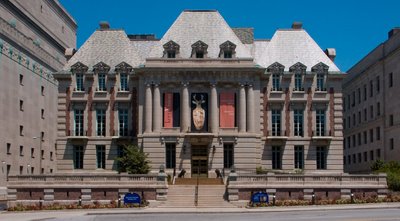
At the Cathedral Basilica of Saint Louis



























At the invitation of Bishop Louis DuBourg, nineteenth century Jesuits arrived in St. Louis in 1823 hoping to work among the Indian people in the St. Louis area. They soon discovered that effective ministry would require the sending of men into the American west while the bishop discovered that the Jesuits could administer a college he had founded in 1818. Saint Louis University was taken over by the Society of Jesus in 1832 and missionaries like Father Peter De Smet, S.J. were sent from St. Louis, following the paths already blazed by St. Louis fur traders and frontiersmen.
The original Indian mission of St. Regis established in Florissant, Missouri, was made over into a Jesuit community dedicated to the training of young Jesuits. For more than 150 years, St. Stanislaus was an academic community and a community of prayer. It was also the "motherhouse" for the Missouri province, a sprawling complex of buildings, farms and orchards. Over time, it became a repository for art, missionary artifacts, books, and basic necessities. When the complex was finally shuttered in 1973, the original stone building on the property was dedicated as a museum. In 2001, the collection housed in the "rock building" was transferred to the Saint Louis University Museum of Art.
Today, the Collection of the Western Jesuit Missions fills the entire third floor of the museum. The artifacts illustrate not just Jesuit and Catholic life but also the frontier experience of the Jesuit missionaries. Art and artifacts reflect a universe of experience, and illustrate art over the centuries and the artifacts of continents and creeds.
Click here for photos of the old Saint Stanislaus Seminary, in Florissant, Missouri, located about 21 highway miles northwest of the museum.

On behalf of the Indians he crossed the ocean nineteen times, visiting popes, kings, and presidents, and traversing almost every European land. By actual calculation he travelled 180,000 miles on his errands of charity.Father De Smet sought to preserve Indian culture and lands, while encouraging among them a moral life: opposing constant warfare between tribes, the enslavement of women, and the consumption of alcohol. He hoped to replicate in North America the relative successes seen with the native peoples in Latin America. But by the time of his death, national policy became overwhelmingly influenced by Darwinism: the struggle between the races was encouraged as an inevitable fight for the "survival of the fittest", and the Indians became targets for elimination. This attitude of our government was only changed in recent decades by new policies of socialism, which are hardly better.
His writings are numerous and vivid in descriptive power, rich in anecdote, and form an important contribution to our knowledge of Indian manners, customs, superstitions, and traditions. The general correctness of their geographical observations is testified to by later explorers, though scientific researches have since modified some minor details. Almost childlike in the cheerful bouyancy of his disposition, he preserved this characteristic to the end, though honoured by statesmen and made Chevalier of the Order of Leopold by the King of the Belgians. That he was not wanting in personal courage is evinced by many events in his wonderful career. Though he had frequent narrow escapes from death in his perilous travels, and often took his life in his hands when penetrating among hostile tribes, he never faltered. But his main title to fame is his extraordinary power over the Indians, a power not other man is said to have equalled. To give a list of the Indian tribes with whom he came in contact, and over whom he acquired an ascendancy, would be to enumerate almost all the tribes west of the Mississippi. Even Protestant writers declare him the sincerest friend the Indians ever had.






























